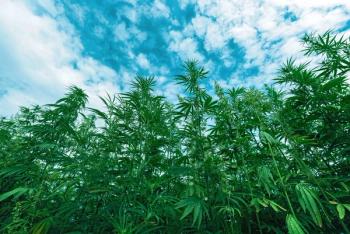
Cannabis Science and Technology
- May 2023
- Volume 4
- Issue 6
- Pages: 12-14
Maximizing Cultivation Efficiency Through the Utilization of Genetic Technology

This article provides insights into the opportunities involving the genetic modification of cannabis.
In our previous article, we touched on the prospective advantages of utilizing clustered regularly interspaced short palindromic repeats (CRISPR) in the production of high-quality cannabis cultivars. This biotechnology has the potential to boost resilience to pests and microbial agents commonly found in cannabis cultivation through the introduction and the extraction of specific genetic traits. This is especially advantageous considering the idiosyncratic challenges that are inherent in cannabis cultivation. These include, but are not limited to: susceptibility to a variety of pathogens, low production of rare or minor cannabinoids, uncontrollable or undesirable ratios of tetrahydrocannabinol (THC) and cannabidiol (CBD), and instability of cannabis genetics. Collectively, these challenges pose significant obstacles to achieving optimal yield and quality. This article provides insights into the opportunities involving the genetic modification of cannabis. With its precision and versatility, CRISPR technology can enable targeted genome editing to enhance pathogen resistance, optimize cannabinoid and terpene profiles, and improve overall plant quality. By harnessing the potential of CRISPR technology, the new frontier of medicine can continue to expand throughout the agricultural sector, meeting the growing demand for high-quality cannabis products, and paving the way towards a more sustainable future.
Cannabis (Cannabis sativa L.) has now become a bona fide tour de force with an established history of medicinal, recreational, and industrial applications. The legalization and widespread acceptance of cannabis and hemp as effective treatments for chronic conditions are driving the expansion of this previously stigmatized plant. As a result, the global demand for cannabis is soaring, leading to the emergence of a substantial enterprise on par with other major crops. In this article, we discuss the challenges associated with cannabis cultivation and propose an innovative solution to overcome these obstacles that can hinder the production of consistent products.
In recent years, there has been significant progress in genome editing technology, which can be utilized for inducing genetic and phytochemical variability in plants such as cannabis. In contrast to traditional plant breeding methods, revolutionary genome editing techniques are distinguished by their higher efficiency and specificity. Through the application of these advanced genetic engineering techniques, it is possible to significantly improve the overall efficiency of cannabis cultivation by modulating specific genes that are involved in conferring resistance to pests and viruses. Additionally, genetic modifications can potentially increase the production of rare or minor cannabinoids, or fine tune the expression of specific tetrahydrocannibinol (THC) and cannabidiol (CBD) ratios.
Despite being a relatively new field, cannabis biotechnology is rapidly expanding due to the accessibility to large-scale genetic engineering techniques. In particular, the clustered regularly interspaced short palindromic repeats (CRISPR or Cas) system has garnered significant notoriety for its ability to perform with high efficiency, specific gene knock-ins (adding of a specific gene), knock-outs (removal of a specific gene), and genetic modifications (altering a specific genetic sequence to attenuate an undesirable trait or accentuate a favorable trait). Initially, this tool was discovered in the microbial “immune system” that prokaryotes—bacteria and archaea—use to prevent infection by viruses called phages. Viruses are small infectious agents that can invade cells and replicate, causing harm to the cell. Comparative genomic analyses between bacteria and archaea suggests that CRISPR and Cas proteins (the cas gene products) work together to provide prokaryotic cells with an acquired immunity system that defends against invading viruses and plasmids, analogous to the eukaryotic ribonucleic acid (RNA) interference (RNAi) system. Interspersed between the short deoxyribonucleic acid (DNA) repeats of bacterial CRISPRs are similarly short variable sequences called spacers, which have been found to be highly homologous to virus or foreign plasmid DNA sequences. These spacers are derived from DNA of viruses that have previously attacked the host bacterium and hence serve as a ‘genetic memory’ of previous infections (1). If another infection by the same virus should occur, the CRISPR defense system will act as “molecular scissors,” cutting out any viral DNA sequence matching the spacer sequence to protect the bacterium from viral attacks. If a previously unseen virus invades, a new spacer is created and added to the chain of spacers and repeats. This technology enables precise genome editing by introducing modifications to the expressed traits of any organism, including the cannabis plant. As a result, high quality unique cultivars with tailor-made levels of phytochemical content and resilience to environmental stressors (pests, bacterial, fungi, and viruses) can be created rapidly, compared to the painstaking and laborious processes required through traditional ‘Mandelian’ breeding techniques.
CRISPR Applications in the Cannabis Industry
Cannabis, much like any other plant, is highly susceptible to pests and pathogens, which can wreak havoc on both indoor and outdoor cultivation environments. Modern cannabis growers are constantly seeking innovative ways to protect their cultivars from harm posed by these pathogens. These pathogens can cause substantial post-harvest losses especially in larger commercial cultivation facilities that present larger degrees of risk. Consequently, growers in a number of domestic and international markets are unable meet the industry demands in production. There are various types of pathogens such as, viruses, bacteria, fungi, nematodes, and insects that are capable of deteriorating the quality of cannabis at any point in the cultivation cycle. Once plants are exposed to these infestations, it can hinder their growth and commercial viability. Even more concerning is the fact that these tiny pathogens can be introduced and spread easily through various means, including wind, rain, soil, insects, contaminated seeds, irrigation, and human contact.
One example of a pathogen that could be controlled through CRISPR-Cas9 intervention is the hop latent viroid (HpLVd). Cannabis is taxonomically related to hops and is a host for the seemingly ubiquitous HpLVd that is the causative agent of “dudding disease” or “cannabis virus.” It consists of a small single-stranded RNA molecule that is transmitted by infected seeds or contaminated plant material. The HpLVd infects the phloem tissue of cannabis plants, which is responsible for transporting nutrients and sugars throughout the plant. Cannabis plants infected with HpLVD can transmit the virus via vegetative propagation of contaminated clones and seeds, which often go unnoticed because the virus can remain latent for prolonged periods of time. The asymptomatic plants make early detection and overall control of the virus extremely challenging. The symptoms of observable indications of HpLVD infections can include stunted growth, yellow misshapen leaves, and brittle stems (2). Additionally, cannabis plants infected with HpLVD exhibit reduced flower mass and reduction of trichome production, which are the highly valuable resinous glandular hairs found on the plant surface that are vital for the production of different classes of phytochemicals (for example, cannabinoids and terpenes). This results in a catastrophic decline in both yield and quality, including as much as a 50% reduction in cannabinoid and secondary metabolite production (3). Unfortunately, HpLVd has a tremendous impact on both financial expenditures and the overall cultivation environment. Growing less efficacious plants requires managing and utilizing larger square footage to produce the same overall phytochemical content, thus contributing to a more resource-intensive enterprise.
Through CRISPR-Cas9 technology, specific genes within the HpLVd genome can be targeted and cleaved, thus preventing the replication, and spread of the virus. Various methods can be used to introduce this system into cannabis plants, such as Agrobacterium-mediated transformation. This method uses a bacterial pathogen, Agrobacterium tumefacies, to introduce genes of interest into the host and editing for CRISPR-Cas9 systems. There is a stable transformation within the nucleus, where DNA is integrated into the cannabis genome and is capable of being passed on to future generations. Transient transformation, on the other hand, permits the DNA to transiently remain within the nucleus and not fully integrate into the plant’s genome, while simultaneously being transcribed to produce desirable traits (4). By utilizing the CRISPR approach, cannabis strains resistant to HpLVd could be developed. With that being said, it is imperative that we understand the genetic makeup of HpLVD, as well as the specific genes and sequences responsible for the virus’ virulence. Prior to introducing modified cannabis cultivars into agricultural practices, it is pivotal to ensure that it does not pose any unintended consequences, such as off target mutations or decreased viability.
The potential applications of CRISPR-Cas technology in cannabis cultivation go beyond the control of plant pathogens. There is a current effort by scientists to utilize CRISPR technology to develop novel cannabis strains with desired traits, such as the elevated expression of rare or minor cannabinoids, secondary metabolites, and the precise regulation of THC and CBD ratios (see Figure 1). To accomplish this, the plant’s genome is precisely edited, and the genes responsible for producing these compounds are introduced and enhanced. For example, utilizing CRISPR-Cas9 to target and attenuate downstream enzymes such as the primary cannabinoid synthases (tetrahydrocannabinolic acid [THCA], cannabidiolic acid [CBDA], and cannabichromene acid [CBCA]) could result in cellular resources being reallocated towards the production of other cannabinoids of interest. This could result in the creation of novel strains that exhibit greater expression of rare or minor cannabinoids and ancillary compounds such as tetrahydrocannabivarin (THCV). Why is this important? Well for one, THCV up-regulates energy metabolism, making it valuable pharmaceutical compound for weight loss, obesity, and Type II diabetes. However, the expression of THCV in cannabis (Group I THC-dominant in particular; generally non-existent in Groups II and III cannabis cultivars) is limited to less than 2% weight/weight (w/w). In addition to the aforementioned example (attenuating the expression of the THCAs, CBDAs, and CBCAs synthases), CRISPR could also potentially amplify the expression of the tetrahydrocannabivarin acid (THCVA) synthase enzyme, which is responsible for the conversion of its progenitor molecule, cannabigerovarinic acid (CBGVA), into THCVA.
Another example of low-hanging fruit for CRISPR utilization is in the large-scale production of CBCA and cannabichromene (CBC). As with the THCVA synthase, CRISPR can target the CBCA synthase enzyme to potentially exploit high CBGA genetics to enhance the production of CBCA and CBC. Due to the extremely low levels of CBCA and CBC in commercial cannabis (~1% w/w), these isolates are extremely expensive and require a tremendous amount of flower material to be processed to produce commercially-relevant amounts of these important neuroprotectants. As such, wholesale pricing for a kilogram of CBC in its purest form (95-99% purity) is approximately $10,000 (6). In addition to labor, resources, and profit, these prices account for all of the expenses associated with producing this isolate. However, CRISPR could potentially create high-CBC producing cannabis strains that can be harvested at a lower cost and eliminate time consuming extraction methods. This would result in affordable and accessible isolates for targeted treatment options for both recreational and medicinal users alike.
The cannabis market is brimming with a plethora of curated strains that have been meticulously crafted to provide cannabis enthusiasts with a one-of-a-kind experience. Based on the plant morphology and foliar arrangement, products were traditionally classified as either Cannabis indica, Cannabis sativa, or Cannabis ruderalis. However, due to widespread crossbreeding and mislabeling of these sub-species, these terms are deceiving and fail to reflect the cannabinoid profile (which is, after all, the primary interest of most consumers). This issue has given rise to a relatively new classification scheme in which the relative levels of THC and CBD expression determine the sub-type of a specific cannabis strain. For example, Group I cannabis cultivars are THC-dominant (>20:1 THC–CBD); Group II consists of ratioed amounts of THC and CBD, (that is, ~1:1, 1:2, or 2:1 THC– CBD); and Group III cannabis (hemp) cultivars are exclusively CBD-dominant (that is, >20:1 CBD–THC).
One scenario where these classifications are paramount to operational success is in the hemp industry. In accordance with the hemp guidelines, a plant that contains more than 0.3% (w/w) of THC cannot be categorized as hemp and must be classified as cannabis. As such, if an organization is designed to cultivate hemp and is doing so with a hemp license—and not a cannabis license—then a lack of the compliance with the 0.3% total THC requirement could result in a partial or complete destruction of their crop, ultimately having catastrophic economic implications. As such, growers in the hemp industry are constantly struggling to find compliant hemp genetics that perform as advertised, which has been one of the major contributing factors to the current struggles endured by those in the American hemp industry. CRISPR has the potential to be the solution to the uncontrollable ratios of THC and CBD. Utilizing CRISPR to target and modify the genes encoding for the CBDA and THCA synthase enzymes, it is possible to increase or decrease their activity within the plant thus modulating the ratios of CBD to THC, respectively. In particular, modulation of the gene encoding CBDA synthase appears to be the best angle of attack compared to trying to dampen THC expression, for the simple fact that THCA is integral to plant viability by allowing cannabis plants to metabolize certain wavelengths of light (7).
Conclusion
Though CRISPR technology is still in its nascent stages, it has the immense potential to revolutionize the cannabis industry. In comparison with traditional breeding techniques, CRISPR's simplicity and versatility makes it a highly efficient tool for enhancing the overall sustainability in cannabis cultivation. This tool can dissect and regulate the cannabinoid biosynthetic pathway that is essential to the improvement of quality and diversity in cannabis. CRISPR has the ability to knock in or knock out the expression of transcription factors or key enzyme genes in the synthesis of effective components or down-regulate them in the competitive pathway to increase the content of active components. Utilizing CRISPR, novel cannabis strains with enhanced resistance to pests and diseases, can be developed, which can result in reduced reliance on harmful chemical pesticides and herbicides. Additionally, CRISPR technology can increase both biological and economic yields by creating cultivars with desirable phytochemical compounds. Overall, with the continued rapid expansion of the cannabis industry, CRISPR is poised to become an indispensable tool for breeders who strive for competitive advantages in a crowded market that is inherently driven by innovation.
References
- Guo, M.; Chen, H., Dong, S.; et al., CRISPR-Cas gene editing technology and its application prospect in medicinal plants. Chin Med17, 2022, 33.
- Warren, J.G.; Mercado, J.; Grace, D., Occurrence of hop latent viroid causing disease in Cannabis sativa in California, Plant Dis., 2019, 103, 2699.
- Adkar-Purushothama, C.R.; Sano, T.; Perreault, J.P., Hop Latent Viroid: A Hidden Threat to the Cannabis Industry, Viruses, 2023,15 (3), 681.
- Li, L.; Yu, S.; Chen, J.; Cheng, C.; Sun, J.; Xu, Y.; Deng, C.; Dai, Z.; Yang, Z.; Chen, X.; Tang, Q.; Su, J.; Zhang, X., Releasing the Full Potential of Cannabis through Biotechnology, Agronomy, 2022, 12 (10), 2439.
- Jacques, A. and Hildenbrand, Z., Hemp Regulations and the Restrictions on Innovation, Cannabis Science and Technology, 2021, 4 (5), 22-24.
- 95-99% CBC Isolate,
https://www.gvbbiopharma.com/product/cbc-isolate/ . - Hildenbrand, Z.L.; Grosella, A.; Manes, R.J.; Liden, T.; Jacques, A.; Spurlock, M.; West, C.; and Schug, K.A., Variable Red Light Exposure Affects Phytochemical Content in Group III Cannabis Cultivars, Cannabis Science & Technology, 2022,5 (6), 30-42.
About the Columnist
Dr. Zacariah Hildenbrand is a research Professor at the University of Texas at El Paso, the principal founder of Inform Environmental, a partner of Medusa Analytical, and is a director of the Curtis Mathes Corporation (OTC:CMCZ). Direct correspondence to:
About the Guest Co-Author
Hannia Mendoza-Dickey is an MS Chemistry student at The University of Texas at El Paso.
How to Cite this Article:
Mendoza, H., Hildenbrand, Z., Maximizing Cultivation Efficiency Through the Utilization of Genetic Technology, Cannabis Science and Technology, 2023, 6(4), 12-14.
Articles in this issue
over 2 years ago
Chromatographic Theory, Part V: Chromatographic Resolutionover 2 years ago
Innovations in Extraction Targeting Specific Wellness Goalsover 2 years ago
The Importance of Air Quality in Cannabis CultivationNewsletter
Unlock the latest breakthroughs in cannabis science—subscribe now to get expert insights, research, and industry updates delivered to your inbox.





